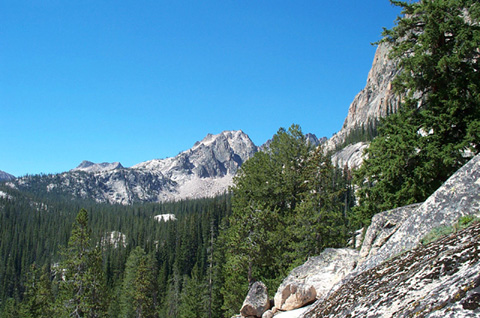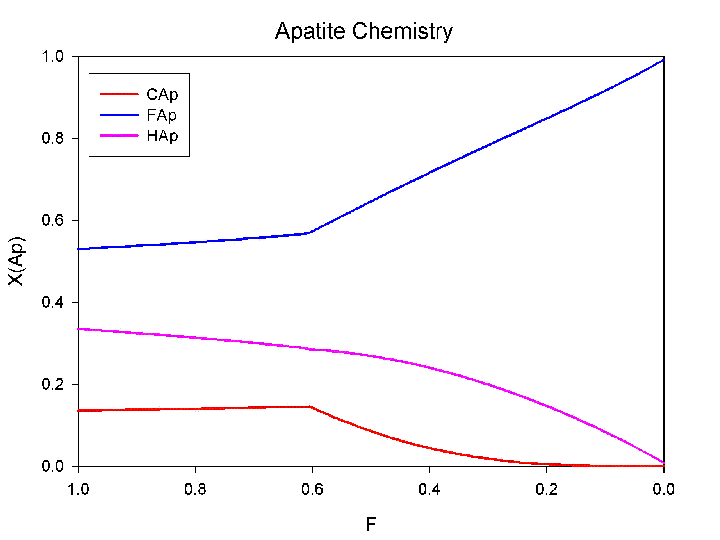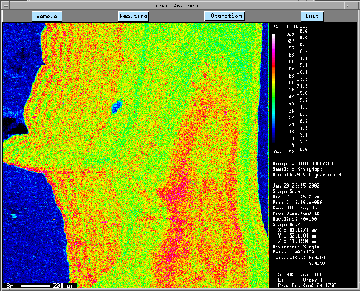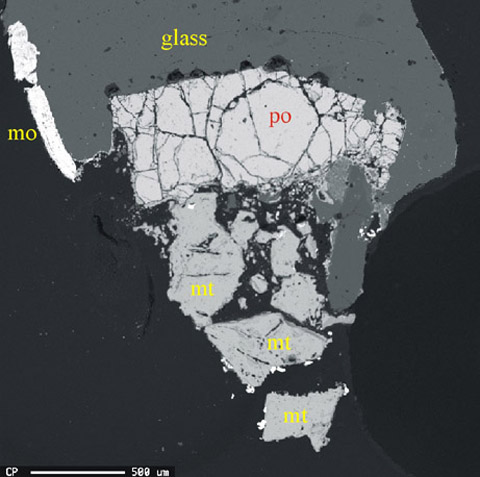

![]()
Dr. Piccoli has a wide variety of research interests. Several examples of his interests are listed below.
Field studies of shallow plutonic and volcanic systems

Image of a portion of the Sawtooth Mountains, Idaho.
At several locations around the world, Dr. Piccoli (with Prof. Philip Candela) is studying textures in shallow granites (sub-volcanic) systems. Granites emplaced at shallow levels in the crust display a vareity of features that are not observed in rocks emplaced deep in the crust. Although much of this work has been concentrated in the Sierra Nevada mountains of California (e.g. see TIS link of Research, Bateman Symposium Poster), a variety of other locations are being studied in this work.
Studies of Apatite Chemistry

Model of the halogen content in apatite crystallizing from
a silicate melt.
The mineral apatite [(Ca5(PO4)3(F,Cl,OH)] is nearly a ubiquotous phase in igneous rocks. It is one of the main repositories for halogens in the crust and mantle of the Earth. For more information on this work, click here.

Beach in Salvador, Bahia, Brazil, outside of the conference
for the Second International Symposium on Granites and Associated Mineralizations.
In part, as an outgrowth of invitations to speak at the Second International Symposium on Granites and Associated Mineralizations
Granite sensu lato is the scum of the earth, the light material that came to the surface to form the crust; it composes the continents on which we live and from which we extract important mineral wealth. A Second International Symposium on Granites and Associated Mineralizations was convened in Salvador, Bahia, Brazil, in August, 1997, to evaluate progress in our understanding of the evolution of the earth's crust, an evolution that involves processes of growth and differentiation through which important metallic elements, such as tin, copper and gold are concentrated into economic mineral deposits. In the ten years since the first ISGAM, we have realized significant developments in the analytical tools available to us in our studies of granites. At the grain scale, these developments have permitted us to collect chemical data with smaller and smaller spatial resolution at lower and lower levels of concentration. At the global scale, we have seen an explosive growth in data collected remotely by satellite-borne instruments. Indeed, the huge growth in data available at all scales has allowed us to advance significantly our understanding of the processes involved in crustal evolution. This Symposium was important, therefore, to evaluate our progress during the past decade and to identify important new research directions.
PGE Alloys in Mantle Rocks (w. R.J. Walker)
Studies of the Migratory Behavior of Anadramous Fish
(w. Prof. D. Secor of the Chesapeake
Biological Laboratory)

Sr x-ray map of the distribution of Sr in an otolith of a
stripped bass.
For more information, press here.
Gold in magmatic systems
Crystal/Melt Experiments
Modeling Natural Systems Using Experimentation

Backscatter electron image of run products from an experiment
to study the partitioning behavior of Mn, Co, Ni, Zn, Au, Mo and W between pyrrhotite
(po) and 'rhyolite'melt (glass). Other phases include magnetite (mt- to impart
an easily determined oxygen fugacity) and molybdenite (a source of Mo). Image
is from Stuller (2001).
This work makes up much of the work in the Laboratory for Mineral Deposits Research.
Analytical Standards

CL image of a quartz phenocryst in the Bishop Tuff rhyolite. The image was taken
using a Patco ELM3R CL system with a KAPPA DX30C camera, at the George
Washington University, under the direction of Prof.
John Hanchar.


Caroline Webber (REU: William and Mary).
UHT UHP belts (with Prof. M. Brown and Dr. Tim Johnson, in addition to workers in Brazil (Dr. Renato de Moraes at the Universidade Federal do Rio de Janeiro
![]()
[Piccoli Home] [Publications]
[Vitae] [Research] [Students]
[Electron Probe Microanalyzer] [Laboratory
for Mineral Deposits Research]
[Sites of Interest] [Classes]
Send comments to: piccoli@umd.edu